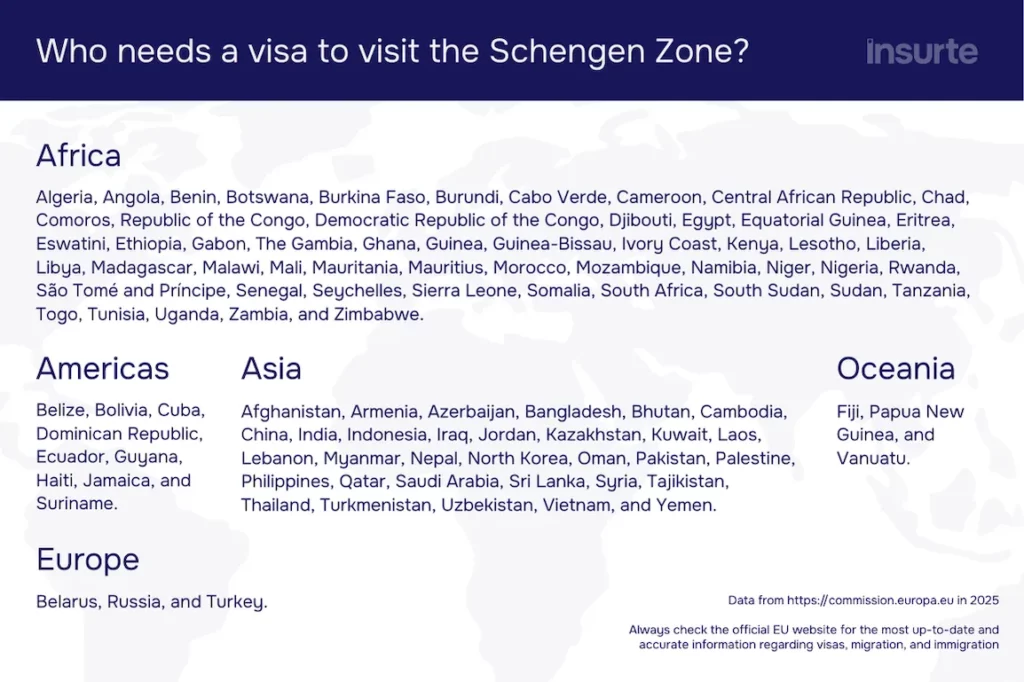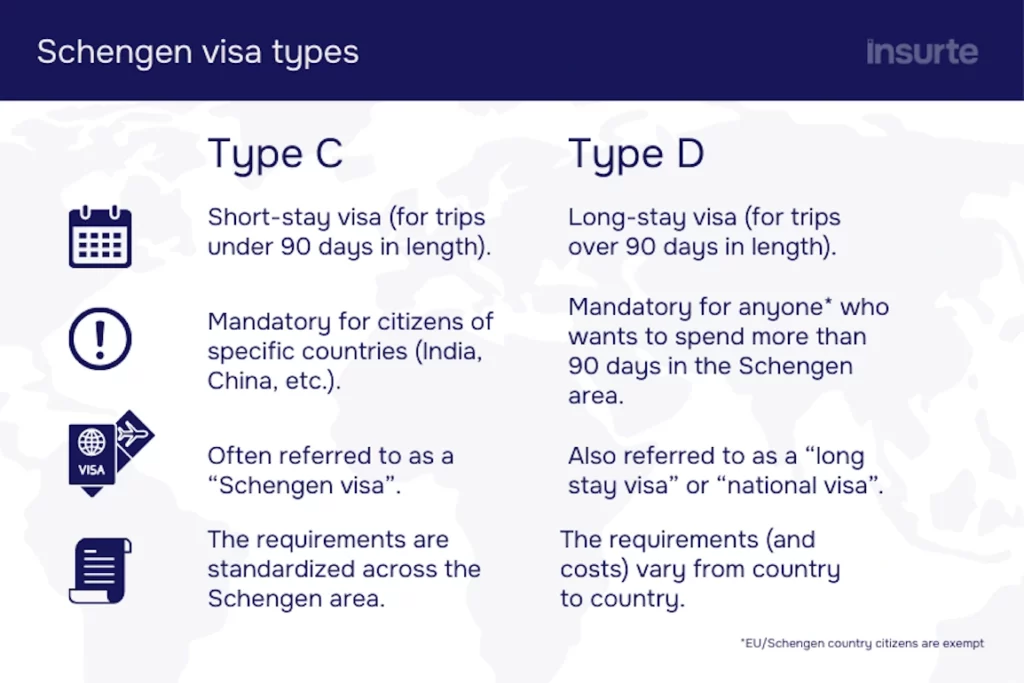Home > Schengen Visa Types: Which One You Need in 2025
Schengen Visa Types: Which One You Need in 2025
When it comes to visas for the Schengen zone, there are several different types. The one that you should apply for depends on how long you're going to stay in the zone, as well as why you're traveling there.
For many travelers, visas are mandatory for Europe, for others, they're not.
We're going to take a look at the different types of Schengen visas and which one you might need. We'll also look over some of the requirements. For example, Schengen travel insurance is mandatory. That isn't the only requirement, though.
Whether you’re beginning your study abroad journey, leaving on an extended work trip, or simply want to visit and explore the Schengen area, you'll find the information you need to know here so you can get the visa application process started.
Different types of Schengen visas
European visas are not a one-size-fits-all. The one you need really depends on why you're traveling and how long you're going to be abroad.
In your research, you may have seen the terms “Type C” and “Type D” Schengen visas.
Each type has its own specific rules and allowances, and Type D also has subtypes. It can sound a little bit complicated at first, but it's actually pretty clear once you understand the terminology.
Type C Schengen visas
The most common type of Schengen visa is the Schengen Type C visa, which allows travelers to stay in the Schengen area for up to 90 days (the exact number of days depends on your specific visa).
The Type C Schengen Visa is the visa that tourists, family visitors, or short-term business travelers generally apply for when they’re planning short trips to the Schengen area.
Who should apply for a Type C Schengen Visa?
Some travelers can go to the Schengen area (for short trips) without a visa. Others can't. Whether or not you can depends on your nationality.
Some countries have what's called a "visa waiver agreement" with the Schengen area. Citizens of countries that have visa waiver agreements can travel to Schengen countries for up to 90 days without a visa (in any given 180-day period).
On the other hand, some countries do not have visa waiver agreements with the Schengen area. If you're a citizen of a country that does not have a visa waiver agreement, you need a Schengen visa to travel to anywhere in the Schengen zone, even if it's only for one day.
If you're a citizen of any of the following countries, you need a visa to travel to France, Spain, Italy, and all of the other 29 Schengen area countries.

African countries that aren't visa-exempt
Algeria, Angola, Benin, Botswana, Burkina Faso, Burundi, Cabo Verde, Cameroon, Central African Republic, Chad, Comoros, Republic of the Congo, Democratic Republic of the Congo, Djibouti, Egypt, Equatorial Guinea, Eritrea, Eswatini, Ethiopia, Gabon, The Gambia, Ghana, Guinea, Guinea-Bissau, Ivory Coast, Kenya, Lesotho, Liberia, Libya, Madagascar, Malawi, Mali, Mauritania, Mauritius, Morocco, Mozambique, Namibia, Niger, Nigeria, Rwanda, São Tomé and Príncipe, Senegal, Seychelles, Sierra Leone, Somalia, South Africa, South Sudan, Sudan, Tanzania, Togo, Tunisia, Uganda, Zambia, and Zimbabwe.
American countries that aren't visa-exempt
Belize, Bolivia, Cuba, Dominican Republic, Ecuador, Guyana, Haiti, Jamaica, and Suriname.
Middle Eastern/Asian countries that aren't visa-exempt
Afghanistan, Armenia, Azerbaijan, Bangladesh, Bhutan, Cambodia, China, India, Indonesia, Iraq, Jordan, Kazakhstan, Kuwait, Laos, Lebanon, Myanmar, Nepal, North Korea, Oman, Pakistan, Palestine, Philippines, Qatar, Saudi Arabia, Sri Lanka, Syria, Tajikistan, Thailand, Turkmenistan, Uzbekistan, Vietnam, and Yemen.
European countries that aren't visa-exempt
Belarus, Russia, and Turkey.
Oceania countries that aren't visa-exempt
Fiji, Papua New Guinea, and Vanuatu.
Type C Schengen visas allow you to enter the Schengen zone and (generally) move freely through it for up to 90 days. This type of visa is typically for citizens from countries that do not have visa-waiver agreements with the Schengen area, such as India or China.
If you’re from a visa-exempt country and are planning a short trip to a Schengen country where you will not be working/studying, you do not need to apply for a Schengen visa at all. Due to a mutual agreement, short-stay visitors from visa-exempt countries are, well, exempt! Visa-exempt countries include the UK, US, Canada, Australia, and many others.
Schengen visa requirements
Schengen travel insurance is mandatory for visa applications. Get your's now.
This doesn't mean you never need a visa, though. If you want to stay in the Schengen area for longer than 90 days, you'll need to apply for one.
Subcategories of the Schengen Type C visa
- Single-Entry Visa: This allows one entry into the Schengen area. Once you leave the Schengen zone, the visa expires, even if you haven't used all the days permitted.
- Double-Entry Visa: This allows two entries. You can leave the Schengen Area once and then return, but the second exit will finalize the visa.
- Multiple-Entry Visa: As long as your overall stay does not exceed 90 days in a 180-day period, you can enter and leave the Schengen area multiple times. This is particularly helpful for frequent travelers.
Type D Schengen visas
Type D Schengen visas are long-term Schengen visas issued for people who intend to stay in the Schengen zone for an extended period (more than 90 days).
These visas are typically used for work, studying, or residency in a specific Schengen country.
If you’re planning to stay in the Schengen area for longer than 90 days, you will need to apply for a Type D visa, regardless of whether or not your country of nationality is visa-exempt.
Type D visas are sometimes called national visas or long stay visas. There are many different types of Type D Schengen visas that vary depending on the country.

What is the difference between a Type D visa and a Schengen visa?
The difference is in terminology. A Type D visa is a type of Schengen visa. However, there are multiple types of Schengen visas.
When people say “Schengen visa", they’re often referring to short-stay Schengen visas (Type C). These are the most common visas, after all.
The difference between Type D visas and Type C visas is straightforward. Type D visas are for visitors intending to stay in the Schengen area for over 90 days. Type C visas are for those staying in the Schengen area for fewer than 90 days.
- Type D: Long stays (90+ days).
- Type C: Short stays (under 90 days).
Citizens from countries that require visas to travel to the Schengen area always need a visa to visit, and typically they get Type C visas for their short stays.
Also, if you are visa-exempt, it doesn't mean you're totally free from entry requirements. ETIAS is launching soon, which will directly affect all visa-exempt travelers.
Additional Schengen visa types
While Types C and D cover the most common travel needs, there are also special categories of Schengen visas for very specific situations, like Type A Schengen visas, which are for travelers who need to transit through a Schengen country on their way to a different destination (outside of the Schengen zone).
Most travelers are allowed to transit through the Schengen area on their way to another destination (the example being a layover during your flight). However, citizens of some countries must obtain a Type A Schengen visa in order to pass through the Schengen area on their way to another country.
Citizens of the following countries must obtain a Type A Schengen visa to pass through:
Afghanistan, Bangladesh, Democratic Republic of the Congo, Eritrea, Ethiopia, Ghana, Iran, Nigeria, Pakistan, Somalia, and Sri Lanka.

Choosing the right Schengen visa
Choosing the right Schengen visa type depends on a few factors:
- Are you a citizen of a visa-exempt country? If not, you need a Schengen visa for your travels. If you are, you may not need one.
- The duration of your trip: Will you be staying for less than 90 days (Type C), or do you need a longer visa (Type D)?
- The purpose of your travels: Will you be working or studying? Or, are you traveling to visit friends or family or for tourism? This will affect which specific visa you apply for within the Type C or D categories.
- Do you have transit needs? If you're simply passing through a Schengen airport or crossing by land, you might need a Type A visa. (Note: This is less common. See which nationalities need a Type A Schengen visa above).
If you’re simply visiting the Schengen area for fun, you will likely need a Type C visa (if you're from a country that does not have a visa waiver agreement).
Our popular visa guides
Applying for a Schengen visa
To apply for any type of Schengen visa, you must go through a visa center or consulate of the Schengen country you’ll arrive in. The process typically involves filling out a visa application form, submitting relevant documentation (such as travel insurance, proof of accommodation, and financial means), and attending an appointment at the visa center or consulate.
Type C Schengen visas for visiting have standardized requirements. This means that no matter which country you're applying for, the requirements are the same across the board.
Type D visas, on the other hand, have requirements that vary greatly from country to country and from subcategory to subcategory.
No matter which visa you need to apply for (if any at all), always pay close attention to the list of requirements given to you by either the visa application center or the consulate/embassy in your country of residence.